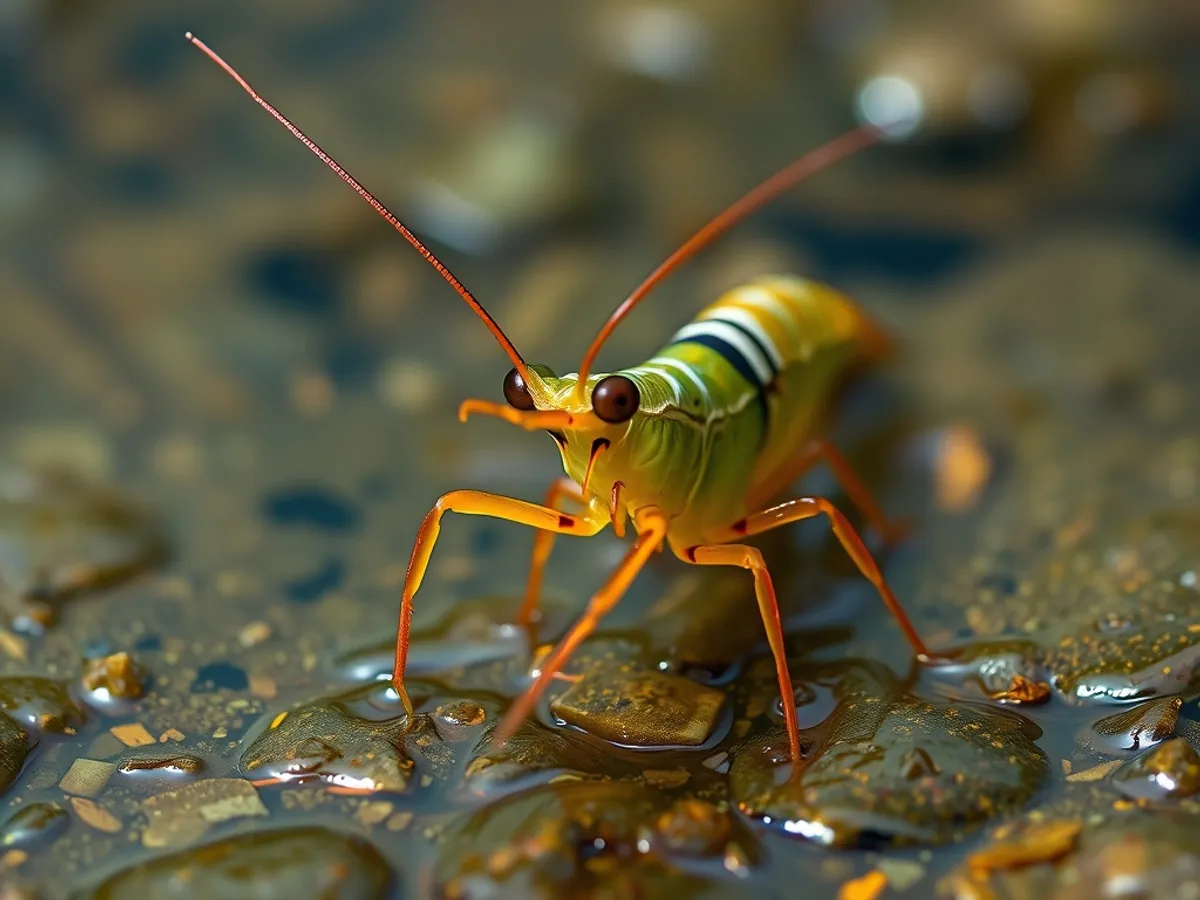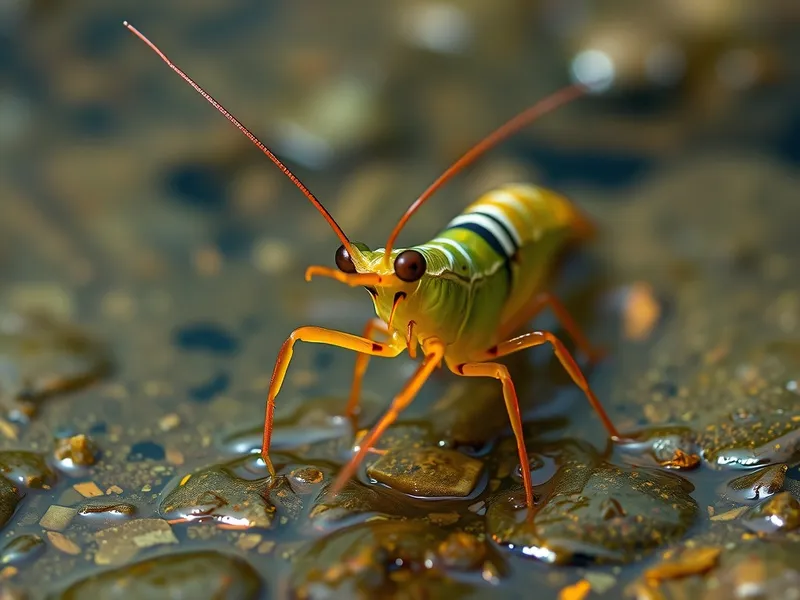
Bamboo Shrimp
Atyopsis moluccensis

Meet the Bamboo Shrimp
The Bamboo Shrimp is a medium-sized freshwater shrimp native to Southeast Asia, known for its unique fan-like appendages that it uses to filter feed from the water. This species has a reddish-brown to tan body, often with a creamy stripe running along its back, and can grow up to 10 cm in length. Bamboo Shrimp are peaceful, social invertebrates commonly found in fast-flowing streams and rivers, where they cling to rocks and filter plankton and detritus from the current. Due to their gentle nature and fascinating feeding behavior, they are popular in freshwater aquariums around the world.
Classification
Invertebrate
Habitat
Freshwater streams and rivers with moderate to strong currents
Diet
Filter feeder (Omnivore)
Lifespan
1-2 years
Conservation
Least Concern
Weight
5-8 grams
📖Fascinating Facts
Unique Feeding Method
Bamboo Shrimp use specialized fan-like appendages to filter tiny particles and microorganisms directly from the water.
Strong Swimmers
They are adapted to live in fast-moving streams and rivers, using their strong legs to cling to rocks and other surfaces.
Difficult to Breed
Their larvae require saltwater to develop, making successful home breeding nearly impossible for most aquarists.
📋Detailed Description
The Bamboo Shrimp (Atyopsis moluccensis) is a large, filter-feeding freshwater shrimp native to the fast-flowing streams and rivers of Southeast Asia, particularly Indonesia, Malaysia, Thailand, and the Philippines. Adults typically reach lengths of 8–10 cm, with females often slightly larger than males. Their exoskeleton is robust and displays a variable coloration ranging from reddish-brown to tan, often with a distinctive pale dorsal stripe running from the head to the tail. The most notable anatomical feature is their first two pairs of chelipeds, which are modified into fan-like setae or 'fans' that they extend into the current to trap suspended particles, plankton, and detritus. The carapace is laterally compressed, and the rostrum is short and serrated. Bamboo Shrimp possess well-developed pleopods for swimming and a powerful tail fan for rapid escape responses. They are primarily nocturnal, spending daylight hours sheltering under rocks or driftwood. Socially, they are peaceful and may form loose aggregations in areas with optimal water flow. Their molting cycle is essential for growth, during which they are vulnerable to predation. The species exhibits sexual dimorphism, with males having larger, more robust first chelipeds. In the wild, they play a significant ecological role in nutrient cycling by filtering organic matter and microfauna from the water column.
💡 Did you know?
Bamboo Shrimp larvae require brackish or marine conditions to develop, which makes breeding them in captivity extremely challenging.
🔬Research & Sources
🎭Behavior & Social Structure
Bamboo Shrimp are specialized filter feeders, positioning themselves facing into the current atop rocks, wood, or other elevated surfaces. They rhythmically open and close their fan-like appendages, sweeping them through the water to capture microscopic food particles. When food is scarce, they may resort to scraping detritus from surfaces or sifting through substrate. They are generally non-territorial and tolerate conspecifics, though mild competition for prime feeding spots can occur. During daylight, they are less active, seeking shelter to avoid predators, and become more active at dusk and during the night. Molting is a critical and vulnerable period, during which individuals hide until their new exoskeleton hardens. In captivity, they may exhibit exploratory behavior and will often congregate near filter outflows or powerheads to maximize food intake.
👶Reproduction & Life Cycle
Atyopsis moluccensis exhibits complex reproductive behavior. Mating occurs shortly after the female molts, when her exoskeleton is soft. Males detect receptive females via pheromones and engage in brief courtship before copulation. Females carry fertilized eggs (up to several thousand) attached to their pleopods for 30–40 days. The eggs are small and numerous, indicating a planktonic larval stage. Upon hatching, larvae are released into the water column and require brackish or marine conditions to develop, passing through multiple zoeal stages before metamorphosing into juvenile shrimp. This amphidromous life cycle means successful captive breeding is rare without access to saline water for larval development. There is no parental care beyond egg brooding, and breeding typically coincides with the rainy season in their native range, when river flows and plankton abundance are highest.
🛡️Adaptations & Survival
Bamboo Shrimp are highly adapted for filter feeding, with their chelipeds transformed into feathery fans lined with fine setae capable of trapping microscopic food particles. Their laterally compressed bodies and strong walking legs allow them to cling tightly to substrates in fast currents. The coloration provides camouflage among leaf litter and rocks. Their ability to rapidly flick their tail enables quick escapes from predators. Physiologically, they tolerate a range of water parameters but require high dissolved oxygen and clean, well-oxygenated water, reflecting their native habitats. The amphidromous reproductive strategy increases larval dispersal and colonization potential across river systems.
📚Research Sources
🎨Cultural Significance
While not a major figure in regional folklore, Bamboo Shrimp are valued in the aquarium trade for their unique appearance and peaceful nature. In some Southeast Asian communities, freshwater shrimp are harvested for food, but Atyopsis moluccensis is not a primary target due to its specialized habitat and feeding habits. Their presence in aquaria has increased public awareness of freshwater biodiversity and the importance of sustainable collection practices.
🔬Recent Research & Discoveries
Recent studies have focused on the larval development of Atyopsis moluccensis, highlighting the necessity of brackish or marine conditions for successful metamorphosis, which has implications for captive breeding programs. Research into their role in stream ecosystems has underscored their importance in nutrient cycling and water filtration. Molecular studies have clarified their phylogenetic relationships within the Atyidae family. Ongoing research is examining the impacts of habitat fragmentation and water pollution on population dynamics. There is also interest in their potential as bioindicators for freshwater ecosystem health due to their sensitivity to water quality changes.
🎥Wildlife Videos

Feeding The Bamboo Shrimp
Information on how to feed the bamboo shrimp, also known as a fan shrimp, a flower shrimp, or a filter feeding shrimp. Plus ...
The Dave

Bamboo Shrimp Care: IN UNDER 5 Minutes
Channel Sponsor Buceplant - http://tinyurl.com/3fu6xckd They have an amazing selection of plants for beginners and experts alike ...
Aquariums with Lefty

Bamboo Shrimp - My little lovely Shrimp
Bamboo Shrimp or Wooden Shrimp.
Leszek Chrzastowski

Bamboo Shrimp: A Beginner's Thoughts
Welcome back to the second video in a series looking into my thoughts and experiences owning these animals. Through my ...
Flying Shrimp Photography

CGTN Nature: Altai Mountains Series | Episode 8: A Resilient Life
Potholes, "stone flowers," and fairy shrimps. Enjoy the embrace of Mother Nature, celebrating the toughness and resilience of life.
CGTN

Bamboo Shrimp Explores After a Water Change
motleymess
🌍Habitat Information
The Bamboo Shrimp typically inhabits Freshwater streams and rivers with moderate to strong currents environments. Bamboo Shrimps have adapted to their environments with specialized features and behaviors.
Primary Habitat:
Freshwater streams and rivers with moderate to strong currents
More detailed habitat information will be available soon.
🛡️Conservation Status
The Bamboo Shrimp is currently classified as Least Concern. Conservation efforts are crucial for preserving this species for future generations.
Common Threats:
- 🏠Habitat loss and fragmentation
- 🌡️Climate change impacts
- 🎯Hunting and poaching
- 🏭Human-wildlife conflict
⚠️Threats & Conservation Challenges
Currently, Bamboo Shrimp are listed as Least Concern by the IUCN, with stable populations across much of their range. However, localized threats include habitat degradation from deforestation, pollution, and damming of rivers, which alter flow regimes and reduce water quality. Over-collection for the aquarium trade can impact wild populations if not managed sustainably. Their dependence on both freshwater and brackish/marine environments for reproduction makes them vulnerable to disruptions in river connectivity. Climate change and increased sedimentation also pose potential long-term threats to their habitats.
🔬Scientific Classification
Scientific Name
Atyopsis moluccensis
Classification Hierarchy
🔍 About Taxonomic Classification
Taxonomic classification is a hierarchical system used by scientists to classify and organize living organisms based on shared characteristics and evolutionary relationships.
The system moves from broad categories (Kingdom) to increasingly specific ones, with each animal's scientific name typically consisting of its Genus and species.
📝Community Notes
Share your observations and insights about the Bamboo Shrimp with our community of wildlife enthusiasts.
Join Our Community
Sign in to share your observations and connect with fellow wildlife enthusiasts.
Sign In to ContributeNo community notes yet
Be the first to share your observations about the Bamboo Shrimp!
Explore Bamboo Shrimp
Select a tab above to learn more about this amazing animal.
📸Photo Gallery
No photos available for this animal yet.
🌟Discover More Wildlife
Continue your journey of discovery with more fascinating animals from our database
